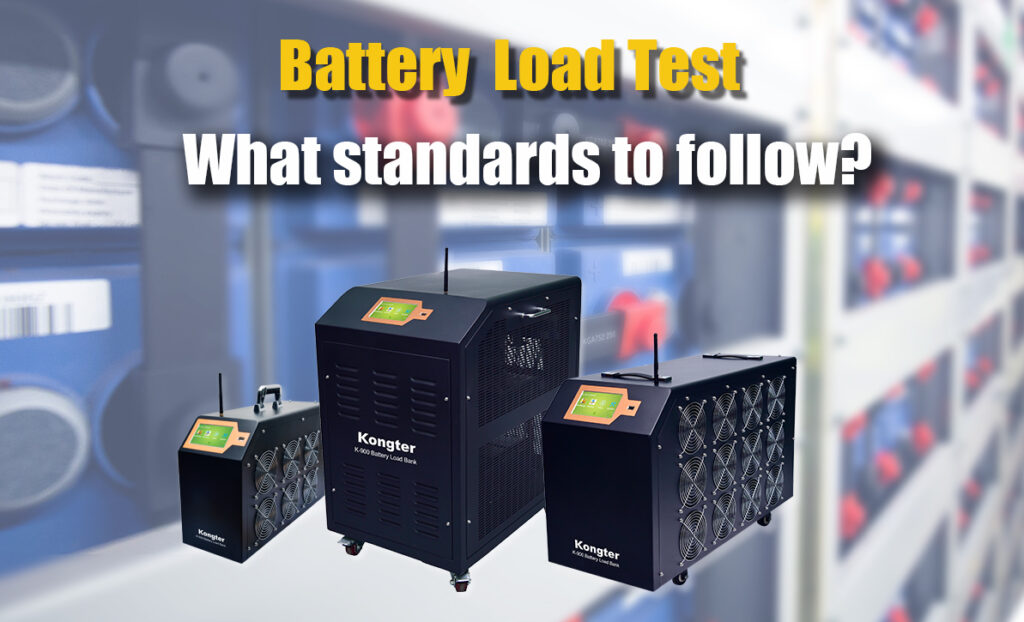There are several industry standards, regulations, and guidelines that apply to battery load bank testing to ensure the safe and accurate evaluation of batteries. The specific standards that may be relevant depend on the type of batteries, the application, and the industry.
Here are some of the key standards and regulations for battery load bank testing. With Kongter’s whole series smart DC Load Bank, you could easily handle these jobs:
1. IEEE 450 – IEEE Recommended Practice for Maintenance, Testing, and Replacement of Vented Lead-Acid Batteries for Stationary Applications: This standard provides guidelines for the maintenance and testing of vented lead-acid batteries used in stationary applications. It includes recommendations for load bank testing.
2. IEEE 1188 – IEEE Recommended Practice for Maintenance, Testing, and Replacement of Vented Nickel-Cadmium Batteries for Stationary Applications: Similar to IEEE 450, this standard focuses on maintenance, testing, and replacement guidelines for vented nickel-cadmium batteries in stationary applications, including recommendations for load bank testing.
3. IEEE 1106 – IEEE Recommended Practice for Installation, Inspection, Maintenance, and Testing of Lead-Acid Batteries for Photovoltaic (PV) Systems: This standard provides guidelines for the installation, inspection, maintenance, and testing of lead-acid batteries used in photovoltaic (solar) systems. It may include load bank testing recommendations.
4. IEEE 485 – IEEE Recommended Practice for Sizing Lead-Acid Batteries for Stationary Applications: While this standard primarily focuses on battery sizing, it may provide guidance on testing and maintaining lead-acid batteries, including load bank testing.
5. IEEE 450.1 – IEEE Guide for Installation, Maintenance, and Operation of Valve-Regulated Lead-Acid Batteries for Stationary Applications: This guide provides recommendations for the installation, maintenance, and operation of valve-regulated lead-acid (VRLA) batteries in stationary applications, which may include load bank testing considerations.
6. NFPA 110 – Standard for Emergency and Standby Power Systems: This National Fire Protection Association (NFPA) standard includes requirements for emergency and standby power systems, including batteries. It may reference load bank testing for these systems.
7. IEC 62619 – Secondary Cells and Batteries Containing Alkaline or Other Non-Acid Electrolytes – Secondary Lithium Cells and Batteries for Use in Industrial Applications: This International Electrotechnical Commission (IEC) standard provides guidelines for the performance and testing of lithium batteries used in industrial applications, which may include load bank testing.
8. Manufacturer’s Recommendations: Battery manufacturers often provide guidelines and recommendations for testing and maintaining their specific battery products, including load bank testing procedures.
9. Local and National Electrical Codes: Depending on the location and application, local and national electrical codes and regulations may dictate the requirements for load bank testing to ensure safety and compliance.
It’s essential to consult the relevant standards and regulations that apply to your specific battery type, application, and industry when conducting battery load bank testing. Compliance with these standards helps ensure the safe and effective evaluation of battery performance and the reliability of backup power systems. Additionally, adherence to these standards is often necessary for regulatory compliance and safety certification.
Consult Kongter to figure out the right smart load bank model that you will need. We build customer tailored models for different industries to meet your requirement exactly.

